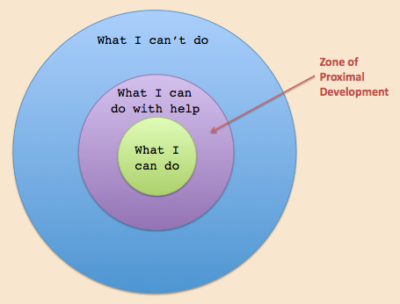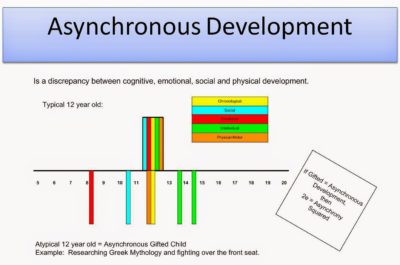Earlier this year a friend of mine, a colleague, a coworker I admire, told me she loved me, she thought I was a great teacher, but she didn’t believe in self-contained gifted classes. She didn’t support what I do as an educator.
She believes my students belong in gen ed classes with everyone else.
At the WAETAG conference some of us on the board overheard attendees talking about differentiation: “This is just good teaching. We can do this in regular classrooms. Why would we need special classrooms for highly capable students?”
Everything I do IS just good teaching. It’s the good teaching every teacher does in their classroom, just meeting the needs of their students.
Here’s the difference. What I do is good teaching at the academic and intellectual depth my students need. It’s good teaching at the pace my students require.
Think about Zones of Proximal Development.
 Think of putting fourth graders into first grade classrooms. That would be ludicrous, right? While the teacher is working with the first graders on “What I can do with help,” the fourth graders are well past the “What I can do” and into the “I’m bored and trying to amuse myself” zone.
Think of putting fourth graders into first grade classrooms. That would be ludicrous, right? While the teacher is working with the first graders on “What I can do with help,” the fourth graders are well past the “What I can do” and into the “I’m bored and trying to amuse myself” zone.
That example may seem like hyperbole, but in a very real way it is not. Students who test two standard deviations above the norm, who are in the top 2% of the population, who historically received (from the world of psychology) the unfortunate appellation “gifted”—those students are not just bright kids in a gen ed classroom. They are children who, intellectually, belong grade levels above.
One traditional solution is acceleration. It’s well researched and demonstrates good outcomes. It works well with students who are not just academically advanced but socially and emotionally mature as well. Illinois recently signed into law the Accelerated Placement Act which “requires Illinois public school districts to adopt and implement policies on acceleration that, at minimum, provide opportunities for early entrance to kindergarten and first grade, opportunities for accelerating a student in a single subject area, and opportunities for “whole grade” acceleration (sometimes referred to as ‘grade skipping’)” [emphasis mine].
Another solution is self-contained classrooms.
 Every year I have several students who are academically advanced but who are socially and emotionally immature. In some cases very immature. One of the defining characteristics of gifted is “asynchronous development.” Gifted students are out of the norm in terms of their development when compared to their age peers. That can mean they are out of the norm in more than just the realm of intellect. Which is why you can have a fifth grader working at the intellectual level of a 15-year-old but acting emotionally like a five-year-old.
Every year I have several students who are academically advanced but who are socially and emotionally immature. In some cases very immature. One of the defining characteristics of gifted is “asynchronous development.” Gifted students are out of the norm in terms of their development when compared to their age peers. That can mean they are out of the norm in more than just the realm of intellect. Which is why you can have a fifth grader working at the intellectual level of a 15-year-old but acting emotionally like a five-year-old.
Whole grade acceleration would not be appropriate for those immature students.
In the self-contained classroom, we provide academic acceleration within the classroom while students stay at their grade-level school and continue to interact with their grade-level peers. More important, our program allows them “to learn with and make social connections with same aged peers who think and learn in the same ways they do” (National Association for Gifted Children) in ways that can’t be replicated in a gen ed classroom, where there just aren’t enough of them in one place to achieve critical mass.
In my classroom, my students not only find the depth and speed of delivery that meets their intellectual needs, but they also find their tribe. They find peers who understand their advanced vocabulary. Who get their quirky jokes.
Meanwhile they enter a world where they aren’t always the first one done or the one with the right answer or the one with the best grade or the one who leads the group. Instead of being the “best” in the class, they become “normal.” It’s a humbling experience.
So let me share some other conversations, also from this fall.
Early in November I asked my students, “What do you like about this class?” There were lots of specific answers, but about half repeated a single theme: “It’s hard.” “It’s challenging.” “I’ve never been so stretched.” Some students raving about how challenging the class was were new to the program this year.
A couple of weeks later in mid-November I got a connect request on LinkedIn. I didn’t recognize the name or photo. So I went to the profile page.
“Robert” was the CEO of an IT company in Seattle. I was really confused. What did a CEO of an IT company want, connecting with an elementary teacher? I googled the company. It was an awesome company. Oh, what the heck, I thought, and I clicked “accept.”
The next day I got an email, not from “Robert” but from “Bobby,” a former student from 1990. He invited me to a party where I could see him and a bunch more of my former students. Of course I said yes!
At the party there was lots of reminiscing about the class they remembered from 27 years ago. Everyone had a different story to tell. But the one thing they all agreed on: “You made us work hard.” “I’d never worked so hard.” “I learned how to work hard in your class.” “After that, everything was easier—because I knew how to work hard.”
By the way, they just remember me as the one who made them work the hardest because I was the last teacher they had in the self-contained program. Then they went to junior high where they no longer received services all day, every day.
Finally, at the end of November, the mother of a new student in my class came to talk with me. Her husband is in the Navy, so the family moves a lot. She says she’s already dreading their next move because, “I’ve never found a program the caliber of this one. We’ve had our children in cluster groups in regular classes, and we’ve had them in one day a week enrichment programs, but we’ve never had them in self-contained gifted classes. The difference is stunning. This year my kids don’t just get piecemeal support. They get all-day every-day stretching in every subject. It’s amazing! I never want to leave.”
My students, my former students, and my parents all agree on the value of self-contained programs.
Not just this year, but every year.